When the heart bleeds
Sanaa -- Sometimes when you’re photographing war, you come across a scene that takes you away from your life as a human being, to another one which has nothing to do with humanity. The massacre at a funeral ceremony in Sanaa a few months ago was such a scene. I found myself staring at a human inferno that I have never seen, even in horror movies.
What was it like? Imagine someone, his legs shaking, walking into a human slaughterhouse. When he gets inside, he sees burning bodies, others completely charred, chopped off heads, amputated legs. Now imagine that among the dead you see friends and colleagues. And add to that the feeling that you are taunting death, because the bombing could start again at any moment.
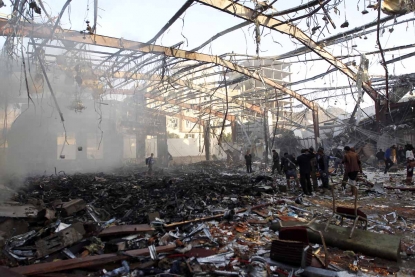 The funeral hall following the air strikes in October, 2016.
(AFP / Mohammed Huwais)
The funeral hall following the air strikes in October, 2016.
(AFP / Mohammed Huwais)I have seen much sadness and misery since 2014, when Iran-backed Huthi rebels overran most of Yemen, leading a Saudi-led coalition to launch a campaign to dislodge them in March 2015. Since the start of that campaign, more than 7,000 people have been killed, nearly 37,000 wounded, countless people displaced and millions have been left in need of food aid. There are people starving in parts of the country.
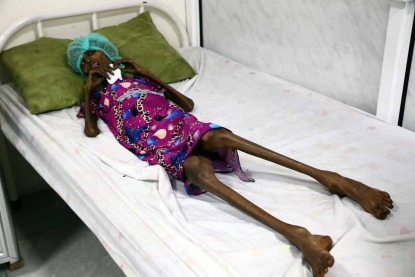 An 18-year-old Yemeni woman from an impoverished coastal village on the outskirts of the rebel-held Yemen port city of Hodeida, where many people are suffering from malnutirition. October, 2016. The UN's children agency UNICEF estimates that three million people are in need of immediate food supplies in Yemen, while 1.5 million children suffer from malnutrition.
(AFP / Stringer)
An 18-year-old Yemeni woman from an impoverished coastal village on the outskirts of the rebel-held Yemen port city of Hodeida, where many people are suffering from malnutirition. October, 2016. The UN's children agency UNICEF estimates that three million people are in need of immediate food supplies in Yemen, while 1.5 million children suffer from malnutrition.
(AFP / Stringer)Unfortunately, the war here in Yemen seems to have taken a backseat to the one in Syria as far as the international community is concerned. The regional and international players are the same in both conflicts, but the focus seems to be on Syria and any solution here seems to depend on what the solution in Syria will be.
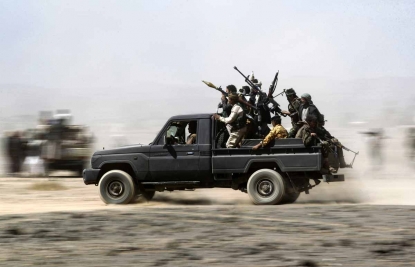 Armed Yemeni tribesmen loyal to the Shiite Huthi rebels on the outskirts of Sanaa, November, 2016.
(AFP / Mohammed Huwais)
Armed Yemeni tribesmen loyal to the Shiite Huthi rebels on the outskirts of Sanaa, November, 2016.
(AFP / Mohammed Huwais)It’s sad, because Yemen has never witnessed something like this, we are experiencing a humanitarian disaster because of this war. Innocent people are dying. The heart bleeds when you think of all the tragedies. And the bombing of the funeral hall was the worst, it was one of the ugliest crimes that I have seen.
I have been a photographer in Yemen since forever, so I’m quite plugged in. When something happens, I usually get a call very quickly. On that day in October, I got a call from my nephew who lives nearby and who told me that a hall holding a funeral appeared to have been hit.
I arrived on the scene around 30 minutes after the second strike. We have gotten used to not going to sites of attacks right away. You give it some time. Often a strike is followed by a second one, which hits the medical personnel and people who are helping the victims, a so-called “double-tap” that has been used the world over to increase the number of victims.
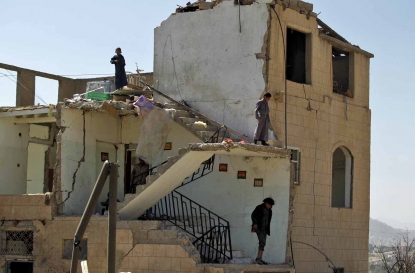 Aftermath of an airstrike on a house in Sanaa, November, 2016.
(AFP / Mohammed Huwais)
Aftermath of an airstrike on a house in Sanaa, November, 2016.
(AFP / Mohammed Huwais)The first thing that I saw when I got to the scene was smoke billowing out of the hall. Could the Saudi air force have hit a hall holding a funeral? I thought to myself. It seemed unbelievable. I saw ambulances taking away the killed and the wounded. There were so many people injured that even civilian cars were taking them away. Then I went inside.
There were bodies and wounded people everywhere. Charred bodies lay near the entrance. Oh God, grant me strength, I said. There were very few paramedics, so I felt that the first thing that I should do is help the ones on the scene try to save the people who were still alive. Near the entrance I saw a man under a car. He was calling for my help. I put my camera aside and started to pull rubble away. Some other people came to help me. We managed to pull him out.
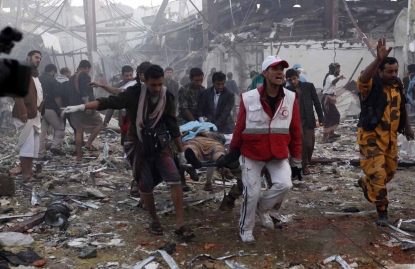 Rescuers work at the funeral hall after the strikes.
(AFP / Mohammed Huwais)
Rescuers work at the funeral hall after the strikes.
(AFP / Mohammed Huwais)I went inside to take photos. God, what about these people’s families? I thought. How will they react when they hear of this disaster?
I didn’t know where to start pointing my camera. Everywhere I went, bodies were still burning. There were wounded and blood everywhere. I remember seeing a hand sticking out of the rubble. It was like a cry for help, like when someone is drowning in the sea, the first thing he does is to raise his hand to call for help. Unfortunately he was already dead.
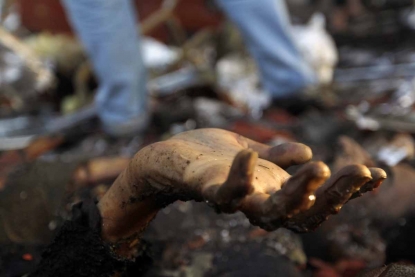 (AFP / Mohammed Huwais)
(AFP / Mohammed Huwais)The whole time that I was taking pictures inside, I was afraid of another strike hitting the venue.
I’ve been caught in such aftermath strikes before. That was the most dangerous situation that I have ever been in as a photographer. I will never forget it, it was at 11 am on May 10, 2015. I was taking photos after an airstrike on the house of ex-president Ali Abdullah Saleh. While I was taking pictures inside the house, another missile hit the house next door. As I ran for cover, another missile hit the exact spot where I had been standing. I thanked God I survived.
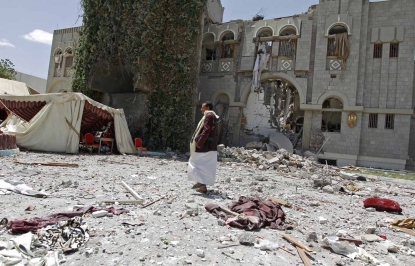 The residence of former Yemeni president Ali Abdullah Saleh following an air strike, May 10, 2015.
(AFP / Mohammed Huwais)
The residence of former Yemeni president Ali Abdullah Saleh following an air strike, May 10, 2015.
(AFP / Mohammed Huwais)The funeral hall strike in October ended up killing more than 140 people and wounding more than 500 others, triggering global outrage in what the UN said was a violation of international humanitarian law. But it will not be the last strike to hit the country. That thought makes me sad. All those painful scenes, they will stay forever in my memory.
I began taking pictures with my father, who was one of Yemen’s first photojournalists in the early 1970s. He taught me how to take pictures. When I started, the situation in the country was stable and safe. I spent most of my time photographing sporting events and life on the street.
 A break from photographing tragedy. A parade in Sanaa, May, 2016.
(AFP / Mohammed Huwais)
A break from photographing tragedy. A parade in Sanaa, May, 2016.
(AFP / Mohammed Huwais)Back then, I never imagined that my lens, which documented beautiful moments on the streets, would turn into one that captured death and tragic scenes that make your heart bleed.
But when you love what you do, it means doing it no matter what. Photography is beautiful and taking pictures of death has not changed my perception of it. Quite the opposite, it has made me realize how great this camera is when you face death, because it allows you to document the crimes that human beings are committing.
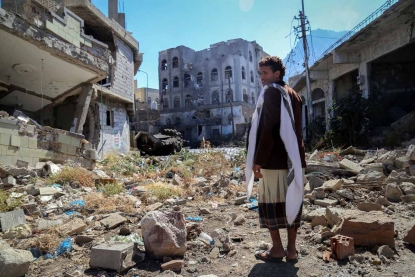 A street in Yemen's third city of Taez following clashes between pro-government militias and rebels, November, 2016.
(AFP / Ahmad Al-basha)
A street in Yemen's third city of Taez following clashes between pro-government militias and rebels, November, 2016.
(AFP / Ahmad Al-basha)When I think about Yemen’s situation as a whole, I don’t feel angry. I feel overwhelmingly sad to see where we have ended up. All this destruction, death, homelessness, the killing of all that is beautiful.
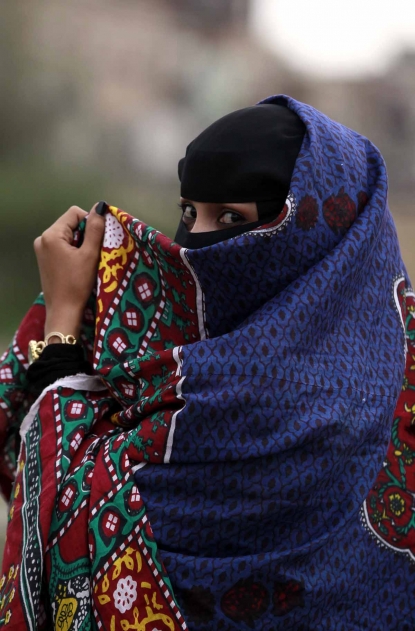 (AFP / Mohammed Huwais)
(AFP / Mohammed Huwais)But despite all this, Yemen is a happy and beautiful place. People are humble and generous. At the moment, the heart of our country is torn apart and bleeding, but despite all the pain, it is still beating with life.
This blog was written with Karim Abou Merhi in Dubai and Yana Dlugy in Paris.
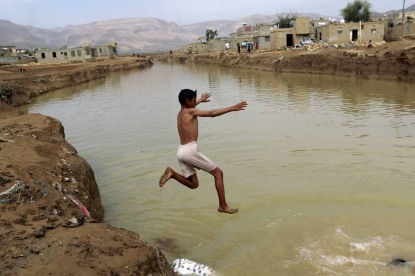 Diving into a flooded field following heavy rainfall north of Sanaa, April, 2016.
(AFP / Mohammed Huwais)
Diving into a flooded field following heavy rainfall north of Sanaa, April, 2016.
(AFP / Mohammed Huwais)





